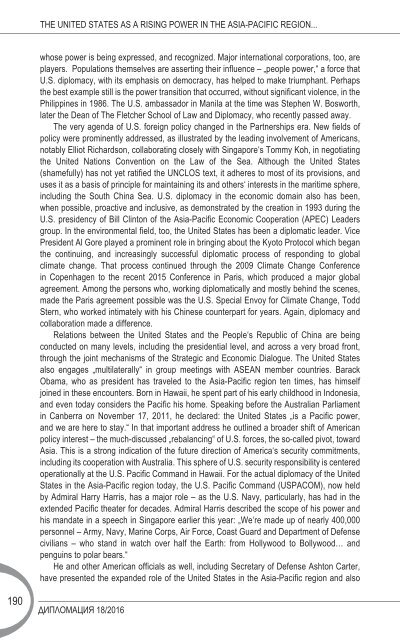DIPLOMACY ДИПЛОМАЦИЯ
2kGfdFv
2kGfdFv
You also want an ePaper? Increase the reach of your titles
YUMPU automatically turns print PDFs into web optimized ePapers that Google loves.
THE UNITED STATES AS A RISING POWER IN THE ASIA-PACIFIC REGION...<br />
whose power is being expressed, and recognized. Major international corporations, too, are<br />
players. Populations themselves are asserting their influence – “people power,” a force that<br />
U.S. diplomacy, with its emphasis on democracy, has helped to make triumphant. Perhaps<br />
the best example still is the power transition that occurred, without significant violence, in the<br />
Philippines in 1986. The U.S. ambassador in Manila at the time was Stephen W. Bosworth,<br />
later the Dean of The Fletcher School of Law and Diplomacy, who recently passed away.<br />
The very agenda of U.S. foreign policy changed in the Partnerships era. New fields of<br />
policy were prominently addressed, as illustrated by the leading involvement of Americans,<br />
notably Elliot Richardson, collaborating closely with Singapore’s Tommy Koh, in negotiating<br />
the United Nations Convention on the Law of the Sea. Although the United States<br />
(shamefully) has not yet ratified the UNCLOS text, it adheres to most of its provisions, and<br />
uses it as a basis of principle for maintaining its and others’ interests in the maritime sphere,<br />
including the South China Sea. U.S. diplomacy in the economic domain also has been,<br />
when possible, proactive and inclusive, as demonstrated by the creation in 1993 during the<br />
U.S. presidency of Bill Clinton of the Asia-Pacific Economic Cooperation (APEC) Leaders<br />
group. In the environmental field, too, the United States has been a diplomatic leader. Vice<br />
President Al Gore played a prominent role in bringing about the Kyoto Protocol which began<br />
the continuing, and increasingly successful diplomatic process of responding to global<br />
climate change. That process continued through the 2009 Climate Change Conference<br />
in Copenhagen to the recent 2015 Conference in Paris, which produced a major global<br />
agreement. Among the persons who, working diplomatically and mostly behind the scenes,<br />
made the Paris agreement possible was the U.S. Special Envoy for Climate Change, Todd<br />
Stern, who worked intimately with his Chinese counterpart for years. Again, diplomacy and<br />
collaboration made a difference.<br />
Relations between the United States and the People’s Republic of China are being<br />
conducted on many levels, including the presidential level, and across a very broad front,<br />
through the joint mechanisms of the Strategic and Economic Dialogue. The United States<br />
also engages “multilaterally” in group meetings with ASEAN member countries. Barack<br />
Obama, who as president has traveled to the Asia-Pacific region ten times, has himself<br />
joined in these encounters. Born in Hawaii, he spent part of his early childhood in Indonesia,<br />
and even today considers the Pacific his home. Speaking before the Australian Parliament<br />
in Canberra on November 17, 2011, he declared: the United States “is a Pacific power,<br />
and we are here to stay.” In that important address he outlined a broader shift of American<br />
policy interest – the much-discussed “rebalancing” of U.S. forces, the so-called pivot, toward<br />
Asia. This is a strong indication of the future direction of America’s security commitments,<br />
including its cooperation with Australia. This sphere of U.S. security responsibility is centered<br />
operationally at the U.S. Pacific Command in Hawaii. For the actual diplomacy of the United<br />
States in the Asia-Pacific region today, the U.S. Pacific Command (USPACOM), now held<br />
by Admiral Harry Harris, has a major role – as the U.S. Navy, particularly, has had in the<br />
extended Pacific theater for decades. Admiral Harris described the scope of his power and<br />
his mandate in a speech in Singapore earlier this year: “We’re made up of nearly 400,000<br />
personnel – Army, Navy, Marine Corps, Air Force, Coast Guard and Department of Defense<br />
civilians – who stand in watch over half the Earth: from Hollywood to Bollywood… and<br />
penguins to polar bears.”<br />
He and other American officials as well, including Secretary of Defense Ashton Carter,<br />
have presented the expanded role of the United States in the Asia-Pacific region and also<br />
190<br />
<strong>ДИПЛОМАЦИЯ</strong> 18/2016


